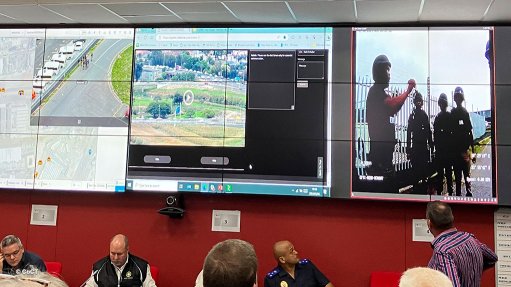
Seen from left to right is a view from a drone delivered to the command centre in Goodwood, the view from the ISR, and live footage from a body cam during a crime combatting event
Very early on in his term, Cape Town Mayor Geordin Hill-Lewis was told by law enforcement agencies that there could never be enough boots on the ground to fully combat violent crime and the drug trade in the city.
What these agencies needed was for the local authority “to go all in” on technology, adding a new layer every time it becomes more widely available and increasingly affordable.
“I’ve done everything to support that vision over the past two-and-a-half years,” says Hill-Lewis.
Hence, the city’s newest crime-combatting tool: an information, surveillance and reconnaissance (ISR) aircraft, also called the Eye-in-the-Sky.
Eye-in-the-Sky is a two-seater piloted Cessna 337 fitted with high-tech cameras able to provide high-definition aerial imagery for smarter policing operations.
The aircraft can fly higher than a drone, and is also fitted with infrared cameras, allowing it to register the heat resonating from a recently fired firearm or body heat in cold water, for example.
The aircraft is to assist in providing actionable information, as well as to improve rapid response time during planned operations as it can relay precise information to law enforcement agencies.
Eye-in-the-Sky has the versatility to cover larger geographical areas than drones, while it can also stay in the air for longer periods doing reconnaissance flights. It is also less weather dependent.
The city also aims for the technology to help guard against vandalism with the monitoring of high-voltage lines and other vital infrastructure, as well as in providing assistance during fire season.
The city this week demonstrated its new aerial surveillance technology to the media during a staged search, rescue and car chase scenario.
The city combined all of its technology, acquired over several years, to showcase its reaction in the case of an armed robbery, with four armed suspects fleeing the crime scene in a hijacked car.
Utilising the city’s drones, the ISR, body cameras (cams), dash cams, the computer-aided dispatch centre based in Goodwood, CCTV and automated numberplate recognition technology, officials showed how technology could be used to corner these suspects with little threat to the public.
The city also has SoundThinking (formerly ShotSpotter) technology installed in areas prone to gang violence.
This acoustic detection technology can pinpoint the location of gunshots in real-time.
It identifies the origin of gunfire via a network of acoustic sensors using triangulation, immediately alerting law enforcement agencies.
With weekends from seven in the evening to three in the morning peak times for gunfire in gang areas, it is hoped that the ISR can, for example, track suspects to their homes after they have fired a gun in a location with SoundThinking technology.
“We are going to keep on making these investments,” says Hill-Lewis.
“We are increasingly attracting South Africa’s best crime experts to work for the city. They would need to tell me what the next stage of technology investment is going to be, and I guarantee you my support.
“In fact, I think I know what it may be, because we have not rolled out body cams to every officer. I think we are on 800 now, but we want every singly officer to have body cams and dash cams.
“Whatever is next after that – we’ll keep on investing,” notes Hill-Lewis.
Cape Town is investing R610-million in various safety technologies over three years, having already spent R200-million in the current financial year.
Despite still being tested, the ISR has already started to earn its keep, notes City of Cape Town Safety and Security MMC JP Smith.
“On 30 April, the city’s Eye-in-the-Sky closely recorded poachers in Hout Bay from kilometres away, enabling a raid on the startled criminals at their residence nearby,” he says.
“Over 3 000 crayfish and a high-powered boat were seized, with the entire crime documented for prosecution.”
Smith, however, laments the time it took to procure the ISR technology, at close on four years, owing to cumbersome national IT tender legislation.
He adds that the South African Police Service and the Hawks both have access to the ISR technology, with a pro-rata fee charged for use of the airplane to help keep it in the air.
Western Cape Premier Alan Winde notes that the next step in enabling more efficient law enforcement in the province will be a link-up between the various municipalities’ CCTV and other crime-fighting systems, enabling officers to track criminals as they move between various nodes.